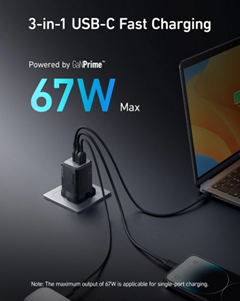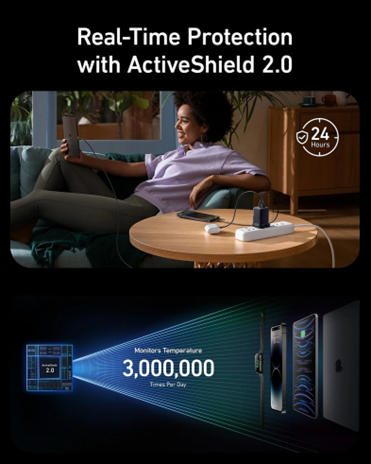How to Choose the Right Charger for Your MacBook Pro?
- الصفحة الرئيسية
- مدونة
- How to Choose the Right Charger for Your MacBook Pro?
For your MacBook Pro to operate at its best and maintain battery life, selecting the correct charger is crucial. Given the wide range of charger alternatives available, it's critical to comprehend the critical elements influencing battery health and charging efficiency. Slow charging, overheating, and even irreversible device damage can result from using an unsuitable or subpar charger. This article helps you make an educated choice for safe and efficient charging by outlining the important factors to take into account when choosing a charger for your MacBook Pro.

Why Is Choosing the Right Charger Important?
The Role of a Charger in Battery Health
A charger is essential for keeping your MacBook Pro's battery healthy. It delivers the appropriate amount of electricity to recharge the battery without overloading or undercharging it. Using a charger with the power output required by your MacBook guarantees that the battery charges effectively and does not deteriorate quickly. Overcharging or undercharging can diminish the battery's lifespan, and using an incompatible charger may prevent the battery from reaching full capacity, resulting in poor performance and shorter battery life.
Consequences of Using the Wrong Charger
Using the improper charger for your MacBook Pro can cause a variety of problems, including overheating, delayed charging, and even irreversible battery damage. If the charger does not give the appropriate power output or is not compatible with your model, it may result in inefficient charging, increased battery wear, and an increased risk of malfunction. Furthermore, a low-quality charger may lack safety safeguards, resulting in short-circuiting, electrical fires, or other hazardous circumstances. To guarantee safety and efficiency, use a charger that meets Apple's suggested standards.
Key Factors to Consider When Selecting a Charger
Power Output and Wattage
A charger's power output, expressed in watts (W), is one of the most crucial aspects to take into account when selecting one for your MacBook Pro. The charger ought to deliver the appropriate wattage to correspond with the power needs of your MacBook. MacBook Pro models, depending on their size and model, usually need chargers with wattages between 61W and 96W. While a charger with too many watts might not be harmful, it might be a needless expenditure and cause slower charging times and battery strain by using one with insufficient power output.
Charging Cable Quality
The quality of the charging cord is as vital as the charger itself. A low-quality or broken cable might result in problems such as irregular power delivery or overheating. Look for cables that are certified for usage with your MacBook Pro to guarantee they can handle the required power output. Apple's official cords are intended to function flawlessly with their devices; however, third-party MFi (Made for iPhone) approved cables are also a viable choice. Make sure the cable is robust and free of any wear that might cause charging issues.
Compatibility with Your MacBook Model
It's critical to get a charger that works with your exact MacBook Pro model. Different MacBook Pro models have different power requirements, and using an unsuitable charger might cause inefficient charging. Apple recommends chargers for each model, and it is preferable to stay with them or ones that meet the exact specs. Some third-party chargers may also be compatible, but they must fulfill the required safety and power requirements. Always check your MacBook's power requirements and match them with the charger's output, such as the macbook charger wattage, to avoid compatibility issues.

How to Ensure Safe and Efficient Charging for Your MacBook?
Avoiding Overheating and Overcharging
Overheating and overcharging are major problems that can shorten your MacBook Pro's battery life. To minimize overheating, use approved chargers with built-in protection against high power flows. When charging, make sure your MacBook is on a level surface with adequate ventilation to enable heat to escape. Additionally, avoid using your MacBook while it is charging for long periods of time, as this might raise the device's internal temperature. Overcharging can potentially cause long-term battery damage. Modern MacBooks are intended to stop charging when the battery is full, but utilizing a correct charger helps to ensure safe charging habits.
Proper Charging Habits for Longevity
Develop proper charging practices to prolong the life of your MacBook Pro's battery. First, don't always have your MacBook plugged in. It's acceptable to sometimes charge the battery to 100%, but for everyday usage, it's preferable to maintain a charge between 20% and 80%. Deep discharges might damage the battery; thus, it's crucial to prevent letting it drop to 0% on a frequent basis. Store your MacBook with the battery at about 50% charge if you won't be using it for a long time. Over time, these procedures and the proper charger can help maintain the health of your battery.
Troubleshooting Charging Issues
If your MacBook Pro is not charging properly, there are a few troubleshooting actions you may take. First, make sure the power supply is working and that the charger is correctly inserted into both the MacBook and the outlet. Inspect the cord and charger for any obvious damage. Try using a different outlet or charger to see whether the problem is with the charger or the device. If the problem persists, reboot your MacBook's SMC (System Management Controller), which might address charging difficulties. If none of these measures work, it may be necessary to seek professional assistance.
Conclusion
For your MacBook Pro to charge effectively and keep its battery healthy, choosing the correct charger is essential. When choosing, take compatibility, power output, and cable quality into account. The longevity of your MacBook's battery may be considerably increased by using the appropriate charger and practicing safe charging practices. Furthermore, maintaining appropriate charging habits and preventing overheating and overcharging are critical to the long-term viability of your gadget. You can protect your MacBook Pro from any charging-related problems and maximize its performance by following these tips.